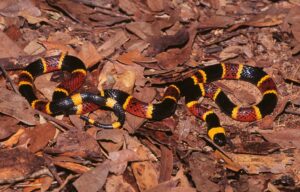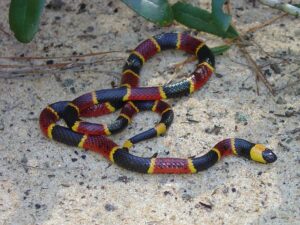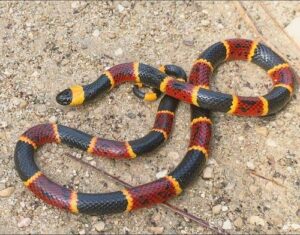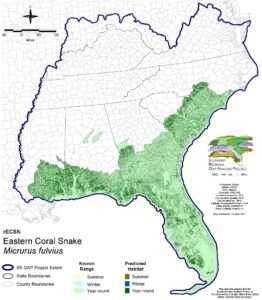The eastern coral snake, common coral snake, or American cobra is a highly venomous elapid endemic to the southeastern US. Other common names of the snake include harlequin coral snake, Elaps harlequin snake, coral adder, candy-stick snake, Florida coral snake, red bead snake, North American coral snake, and thunder-and-lightning snake.
Scientific Classifications
- Suborder:Serpentes
- Family:Elapidae
- Genus:Micrurus
- Species:M. fulvius
Conservation Status
Description
Size
The snake is generally less than 31 in (80 cm) in total length, including the tail. The maximum recorded sizes are 48 in (121.8 cm) for an individual from Florida and 51 in (129.5 cm). Females are longer than males, but their tails are shorter.
Color and Appearance
A series of rings encircle the body. There are red and black rings with narrow yellow ones in between. The red rings have black speckles. The black color of the head extends from the rostral scale to just behind the eyes.
The snake has a divided anal plate and smooth dorsal scales arranged in 25 rows at the midbody. There are 197-217 ventral scales in males and 219-233 in females. The subcaudals number 40-47 in males and 30-37 in females.
Are They Dangerous to Humans
Being a potent neurotoxin, the venom of the common coral snake causes rapid respiratory failure and paralysis in its prey. In humans, the symptoms include double vision, slurred speech, and muscular paralysis leading to respiratory failure. But eastern coral snake bites and fatalities are very rare as the secretive snake is generally reluctant to bite. Moreover, 60% of its bites are dry, with only 40% associated with venom secretion.
The snake has no control over the amount of venom injected but holds enough to kill up to 5 adults. However, it is unable to release all the venom in a single bite. The mortality rate is assumed to be 10-20%, with deaths occurring in as little as 2 hours and as much as 26 hours after the bite.
Eastern Coral Snakes at a Glance
Distribution
Its range extends from southeastern North Carolina, southward through peninsular Florida and South Carolina, and west through Alabama, Mississippi, and southern Georgia to southeastern Louisiana.
Habitat
The harlequin coral snake lives in tropical and upland mesophytic hammocks in Florida, as well as high pine, scrub oak, glade land, and live oak hammocks, wiregrass and slash pine flatwoods. Generally, it occurs at altitudes from sea level to about 1300ft (400 m).
Southern Georgia and Florida have them only in dry areas with open, bushy grounds that are not heavily vegetated. In Mississippi, they inhabit sandy ridges, and in Louisiana, they can be found in sandy creek bottoms. North and South Carolina have them in pitch pine habitats near the coast, southeastern coastal plains, and scrub oak forests.
Lifespan
It can live up to 7 years in captivity, but its lifespan in the wild is unknown.
Predators
The elapid falls prey to mammals like raccoons and foxes, birds of prey like hawks, eagles, owls, storks, and buzzards, and other snakes.
Diet
It eats birds, lizards, frogs, insects, fish, and smaller snakes, including other coral snakes.
Reproduction
Oviparous (lays eggs that hatch outside the body)
The females lay 3-12 eggs in June that hatch in September. The neonates are 7.1-9.1 in (18-23 cm) in size. 11-16 months post-hatching, the males reach maturity, while it is 26 months for the females.
Similar Species
The scarlet kingsnake, Lampropeltis elapsoides, has alternating bands of red, black, and yellow, with the red touching the black but not the yellow. In the harlequin coral snake, the red touches the yellow but not the black.
The Texas coral snake, Micrurus tener, is longer and stouter and has a larger venom yield.
Source
herpsofnc.org, gannett-cdn.com, inaturalist.ca, i0.wp.com, squarespace-cdn.com, wildlife-removal.com











